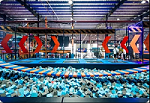


Stress relief trampoline parks face safety, maintenance, staffing, and innovation challenges for sustained long-term operation.
Trampoline parks designed for stress relief purposes occupy a unique niche in the indoor recreation industry. Combining physical exertion with psychological decompression, these facilities cater to a demographic seeking therapeutic movement rather than mere entertainment. However, maintaining a long-term operation of such venues entails a distinct set of technical and managerial hurdles.
Trampoline park equipment endures continuous kinetic stress, particularly in high-usage areas like open jump zones, foam pits, and wall trampolines. Over time, tensile materials lose elasticity and springs suffer from metal fatigue, increasing the risk of failure. Regular inspections and replacements are imperative but cost-intensive.
Meeting evolving safety regulations compounds the issue. Regulatory bodies such as ASTM International or local municipal codes frequently update safety standards for indoor rides and active amusement centers. Operators must retrofit or replace equipment to remain compliant, often without a clear return on investment.
Unlike general indoor rides, stress relief trampoline parks often demand a tranquil atmosphere—filtered lighting, acoustic insulation, and air circulation systems that support physical activity without overexertion. High ceilings and large open spaces require extensive HVAC capabilities, which results in elevated operational overhead.
Additionally, constant foot traffic accelerates degradation of flooring, wall padding, and soft materials. These environmental elements must maintain cleanliness and tactile integrity, as many patrons attend with wellness or therapeutic intent. Standard cleaning is insufficient; medical-grade sanitation may be required to meet user expectations.
Stress relief does not negate physical risk. The perception that such parks offer a “low-impact” experience often leads to relaxed behavior from patrons, yet injuries from poor landings, overexertion, or unsupervised activities remain prevalent. This creates a dual burden: preserving the relaxed image while enforcing rigorous safety protocols.
Insurance premiums for indoor trampoline operations are among the highest in the recreational sector. Providers typically demand advanced incident monitoring systems, waiver automation, and real-time supervision—further adding to operational complexity.
The novelty of trampoline park equipment, including those themed around mindfulness or stress relief, tends to decline over time. Without frequent reinvention—new class offerings, integrated indoor rides, or seasonal events—customer return rates plateau.
User expectations evolve. Where simple jump time once sufficed, modern patrons seek immersive experiences that blend entertainment with wellness, such as guided trampoline meditation or sensor-assisted fitness metrics. Incorporating these features requires investment in both technology and staff training, straining financial models.
Traditional trampoline parks can operate with minimal training. In contrast, stress relief-centric operations often require employees versed in kinesiology, psychology, or fitness instruction. Staff must manage not only equipment zones but also facilitate emotional well-being and encourage mindful activity.
This narrows the labor pool, increases wages, and necessitates ongoing training in de-escalation techniques, first aid, and customer service. High turnover in the recreation industry only amplifies these difficulties.
Operating a trampoline park focused on stress relief is an inherently multidimensional challenge. Beyond the maintenance of trampoline park equipment and indoor rides, operators must continuously evolve with safety regulations, customer expectations, and specialized staffing needs. While these venues fulfill a growing societal need for active wellness, their long-term sustainability hinges on rigorous management, continual innovation, and a willingness to invest beyond the initial excitement of launch.
